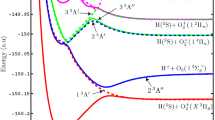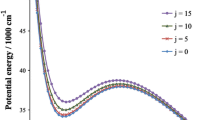Summary
TheC 2v symmetry section of the Be(3 P)+ H2(1ε + g ) adiabatic energy surface is investigated by using the CAS SCF method. The small active space CAS SCF calculations in the valence approximation are followed by a perturbation treatment of the dynamic, core, and core-valence contributions in the framework of the CASPT2 method. The possibility of the nonradiative chemical deactivation of the lowest triplet state of Be by the insertion mechanism is studied. The structure of the3 B 2 reaction intermediate BeH2 is established. The calculations show that the symmetric dissociation of this intermediate into Be(1 S) and 2H(2 S) does not involve any barrier beyond the endothermicity of the corresponding reaction. The hydrogen abstraction mechanism via a linear configuration is shown to possess the activation barrier of about 25 mH.
Similar content being viewed by others
References
Breckenridge WH, Umemoto H (1982) Adv Chem Phys 50:325
Breckenridge WH (1982) In: Clyne MAA, Fontijn A (eds) Reactions in small transient species. Academic Press, New York, p 157
Poirier RA, Peterson MR, Menzinger M (1983) J Chem Phys 78:4592
Adams N, Breckenridge WH, Simons J (1981) Chem Phys 56:327
Breckenridge WH, Stewart J (1982) J Chem Phys 77:4469
Breckenridge WH, Nikolai WL (1980) J Chem Phys 73:2763
Roos BO (1987) Adv Chem Phys 69:399, and references therein
Andersson K, Malmqvist PA, Roos BO, Sadlej AJ, Woliński K (1990) J Phys Chem 94:5483
Almlöf J, Taylor PR (1987) J Chem Phys 86:4070
Widmark PO, Roos BO, Malmqvist PÅ (1990) Theor Chim Acta 77:291
Karlström G, Malmqvist PÅ, Roos BO, Sadlej AJ, Widmark PO (1990) MOLCAS System of Quantum Chemistry Programs. Release 01. Theoretical Chemistry, University of Lund, Lund, Sweden. See also: Roos BO, Karlström G, Malmqvist PÅ, Sadlej AJ, Widmark PO (1990) In: Clementi E (ed) Modern techniques in computational chemistry: MOTECCtm-90. ESCOM, Leiden, p 533
Andersson K, Fülscher M, Lindh R, Malmqvist PÅ, Olsen J, Roos BO, Sadlej AJ, Widmark PO (1991) MOLCAS System of Quantum Chemistry Programs. Release 02. Theoretical Chemistry, University of Lund, Lund, Sweden. The ANO basis set library constitutes a part of the MOLCAS/02 System
Huber KP, Herzberg G (1978) Molecular spectra and molecular structure. Vol 4. Constants of diatomic molecules. Van Nostrand-Reinhold, New York
Bashkin S, Stoner Jr JA (1975) Atomic energy levels and Grotrian diagrams. North-Holland, Amsterdam
Sevin A, Chaquin P, Papakondylis A (1990) Chem Phys Lett 174:185
Author information
Authors and Affiliations
Rights and permissions
About this article
Cite this article
Kellö, V., Sadlej, A.J. A CAS SCF study of reactive interactions between Be(3 P) and H2(1ε + g ). Theoret. Chim. Acta 81, 417–424 (1992). https://doi.org/10.1007/BF01134865
Received:
Accepted:
Issue Date:
DOI: https://doi.org/10.1007/BF01134865




